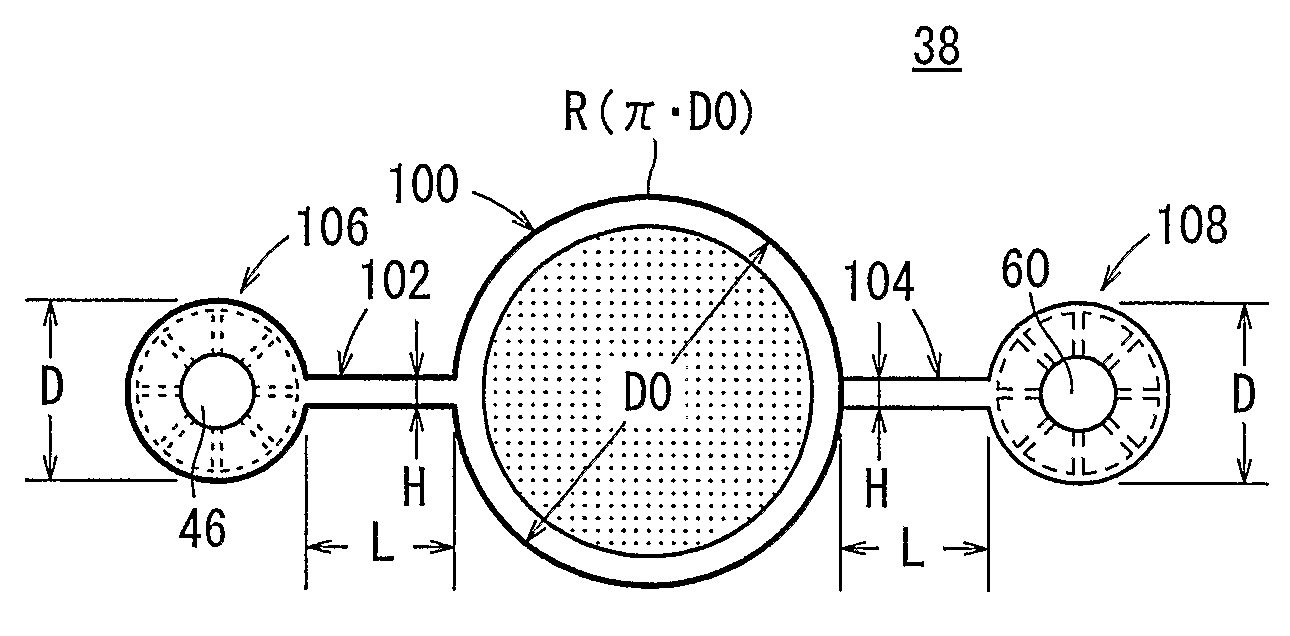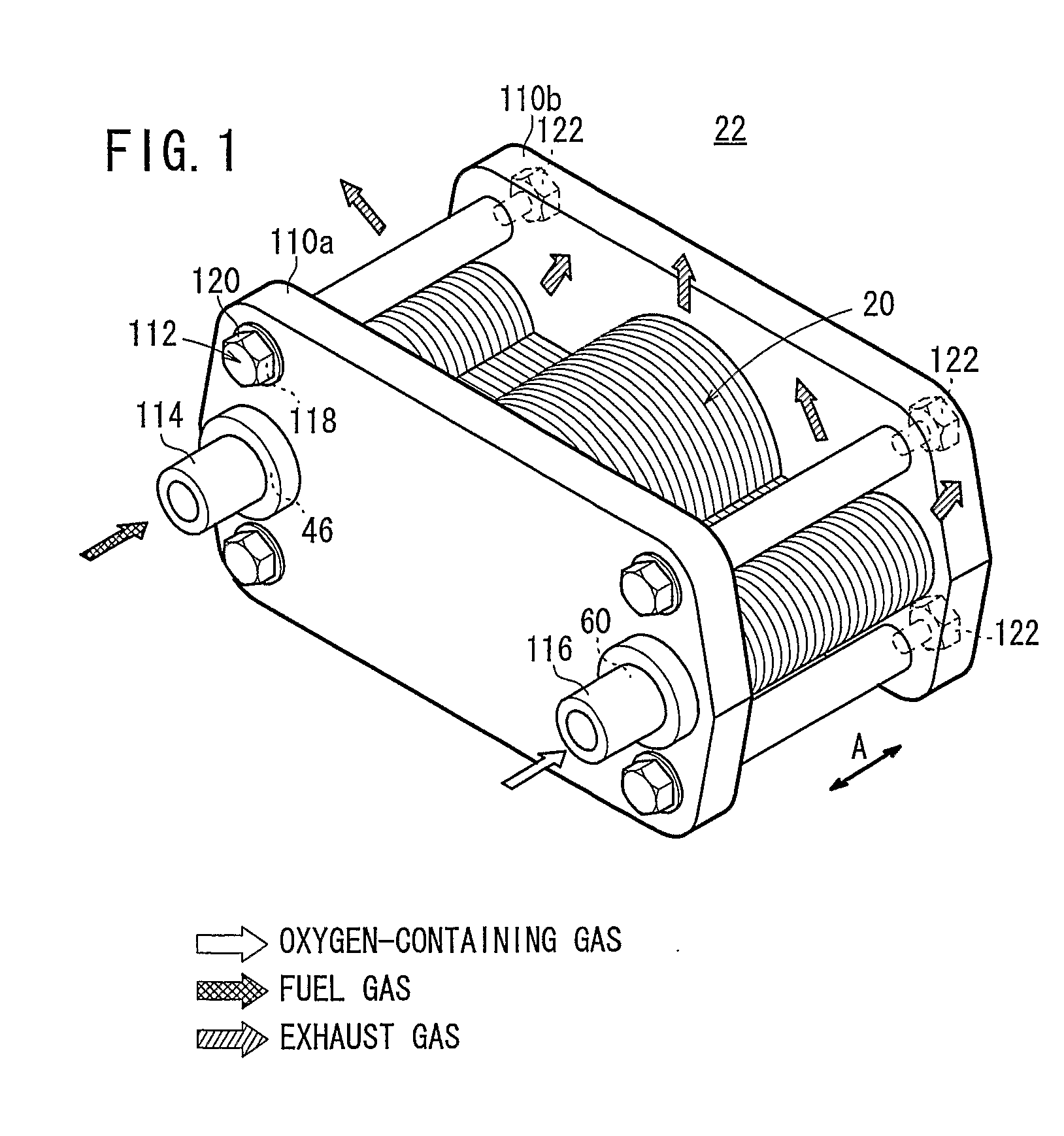Fuel cell separator
a fuel cell and separator technology, applied in the field of fuel cell separators, can solve the problems of unit cell b>2/b> being damaged undesirably, power generation output not being efficiently performed, and unit cell b>2/b> being lowered undesirably
- Summary
- Abstract
- Description
- Claims
- Application Information
AI Technical Summary
Benefits of technology
Problems solved by technology
Method used
Image
Examples
first embodiment
[0059]FIG. 1 is a perspective view schematically showing a fuel cell stack 22 formed by stacking a plurality of fuel cells 20 each including a fuel cell separator according to the present invention in a direction indicated by an arrow A.
[0060]The fuel cell 20 is a solid oxide fuel cell (SOFC), and used in various applications, including stationary and mobile applications. As shown in FIGS. 2 and 3, the fuel cell 20 includes an electrolyte electrode assembly 36. The electrolyte electrode assembly 36 includes a cathode 32, an anode 34, and an electrolyte (electrolyte plate) 30 interposed between the cathode 32 and the anode 34. For example, the electrolyte 30 is made of ion-conductive solid oxide such as stabilized zirconia. The electrolyte electrode assembly 36 has a circular disk shape.
[0061]The fuel cell 20 is formed by sandwiching the electrolyte electrode assembly 36 between a pair of separators 38. As shown in FIG. 2, the separator 38 includes first and second plates 40, 42, and...
second embodiment
[0103]The fuel cell 130 includes a pair of separators 132 according to the present invention. Two electrolyte electrode assemblies 36 are sandwiched between the separators 132. As in the case of the separator 38, the separator 132 is made up of three plates (not shown). As shown in FIGS. 9 and 10, the separator 132 includes a first sandwiching section 100a having a circular disk shape and a second sandwiching section 100b having a circular disk shape for sandwiching the electrolyte electrode assemblies 36, respectively.
[0104]The first sandwiching section 100a and the second sandwiching section 100b are connected to a manifold 106 through bridges 102a, 102b. Further, the first sandwiching section 100a and the second sandwiching section 100b are connected to a manifold 108 through bridges 104a, 104b. Fuel gas supply channels 86a, 86b are formed in the bridges 102a, 102b, and oxygen-containing gas supply channels 94a, 94b are formed in the bridges 104a, 104b.
[0105]A fuel gas channel 5...
third embodiment
[0110]FIG. 11 is a perspective view schematically showing a fuel cell stack 142 formed by stacking a plurality of fuel cells 140 each including a fuel cell separator according to the present invention.
[0111]The fuel cell stack 142 is formed by stacking a plurality of fuel cells 140 in a direction indicated by the arrow A. Each of the fuel cells 140 has a circular disk shape having an outer curved section. End plates 144a, 144b are provided at opposite ends of the fuel cells 140 in the stacking direction, and a plurality of, e.g., eight tightening bolts 146 and nuts 148 are used for tightening components between the end plates 144a, 144b.
[0112]A circular fuel gas supply passage 46 extends through the center of the fuel cell stack 142 in the direction indicated by the arrow A, and the end plate 144a forms the bottom of the fuel gas supply passage 46 (see FIGS. 12 and 13). A plurality of, e.g., four exhaust gas channels 97 extending in the direction indicated by the arrow A are formed...
PUM
| Property | Measurement | Unit |
|---|---|---|
| angle | aaaaa | aaaaa |
| angle | aaaaa | aaaaa |
| circumferential length | aaaaa | aaaaa |
Abstract
Description
Claims
Application Information
 Login to View More
Login to View More - R&D
- Intellectual Property
- Life Sciences
- Materials
- Tech Scout
- Unparalleled Data Quality
- Higher Quality Content
- 60% Fewer Hallucinations
Browse by: Latest US Patents, China's latest patents, Technical Efficacy Thesaurus, Application Domain, Technology Topic, Popular Technical Reports.
© 2025 PatSnap. All rights reserved.Legal|Privacy policy|Modern Slavery Act Transparency Statement|Sitemap|About US| Contact US: help@patsnap.com



